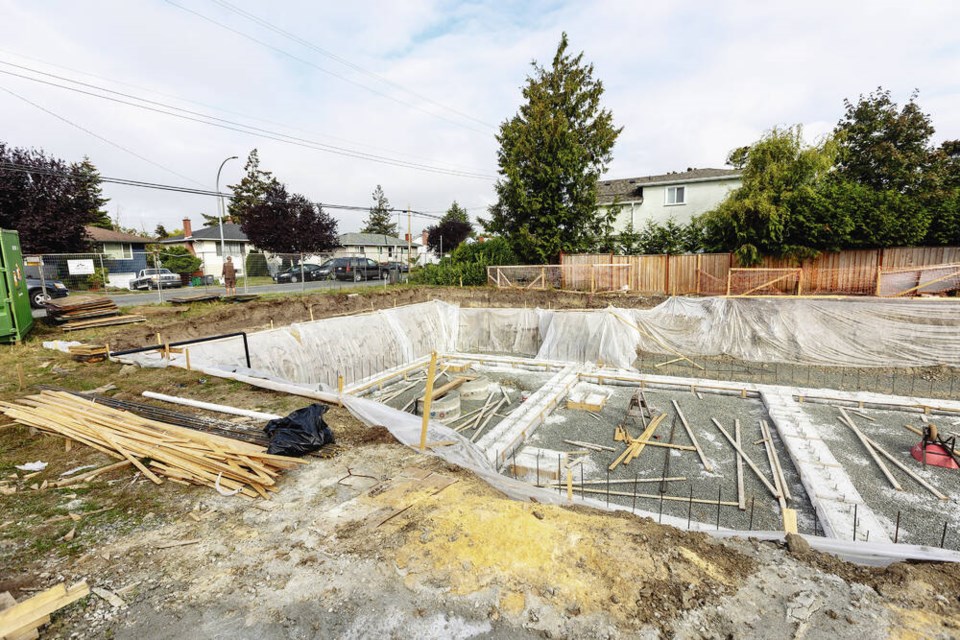Saanich is looking at reducing off-street parking requirements for new developments in line with practices the mayor says have already been in place for more than a decade.
On Monday, council will consider amending the zoning bylaw to reduce the minimum number of parking spaces required for housing projects of fewer than 12 units to one stall per unit.
For developments of more than 12 units, developers would be allowed to offer a maximum of 1.5 parking stalls per unit. They would also need to provide a transportation demand management plan.
Previously, 1.5 parking stalls per unit had to be provided for apartments, while two stalls per unit were required for attached housing such as townhouses.
“I can’t recall a project in recent memory that’s larger than 12 units that didn’t require a parking variance because our parking requirements set out 1.5 or two parking stalls per unit,” said Mayor Dean Murdock.
“Because that’s been a pretty regular practice to have that variance, updating the zoning bylaw reflects the reality that most of those buildings will probably provide one parking stall per unit.”
The changes will eliminate the need for a variance and acknowledge what has effectively been Saanich’s practice for more than a decade, he said.
Murdock said the idea of combining maximums with a transportation demand management plan is to ensure enough alternatives are provided so residents use transit or car-share rather than having a spillover of parked cars on neighbouring streets.
The new rules would require developers to choose from a menu of transportation demand measures that include transit, cycling and car-share amenities.
As a further streamlining measure, district staff will approve permits rather than council having to deal with them.
Murdock said reducing the required number of parking stalls should bring down housing costs, since developers estimate the cost of underground parking can range between $75,000 and $100,000 per stall.
“[Parking] significantly escalates the cost of construction, which either means the project is a non-starter because the pro forma just doesn’t work, it’s not cost-effective to build that type of building, or a developer needs such a high level of density to offset those costs that it puts them in a different set of requirements for variances,” he said.
“What we’re hoping we can do is actually get a more suitable building type in our centres and corridors by reducing that requirement and therefore reducing those costs.”
For those changes to be successful, however, Saanich will need to be more walkable, cycling-friendly and transit-accessible.
While the district continues to invest in cycling infrastructure and is directing development to corridors and centres close to amenities and on main B.C. Transit routes, the infrastructure is still behind the curve, according to some community associations.
“The challenge in Saanich and I would probably venture to say Greater Victoria is that doing this before we have excellent transit is a challenge,” said Hollis Hodson, president of the Carey Area Residents Association, noting the assumption seems to be if parking is minimized, people will change their behaviour.
She said in some cases, younger people may already be doing that, but they have difficulties finding housing in areas that are walkable or are close to some form of transit.
The other problem is: “Is the transit actually taking you where you need to go in a timely fashion?” she said, noting it’s one thing to get on a bus to get to work downtown, but it’s quite another if your work is out on the Saanich Peninsula.
She also wondered what happens to tradespeople who need larger vehicles to get to work and to haul tools and material.
“Are you telling them their one minimum parking stall is for their truck and you want them driving around in their truck, contributing to the climate [issues]?” she said.
“I appreciate that you have to start somewhere and that the shift has to happen. The question becomes, where’s the transition plan from today to get to there with reasonableness?”
Asked about transit not keeping up with demand, Murdock said a service increase is in the works, and B.C. Transit has budgeted for increased hours and vehicles.
“Our part as a municipality is to ensure that we are locating folks in areas where they’re going to use public transit,” he said, including along major corridors.
“By locating more folks in areas where they can walk to the bus to get to where they need to go, we’re going to make it less likely that they’re going to have to use a car to get around.”
>>> To comment on this article, write a letter to the editor: [email protected]



